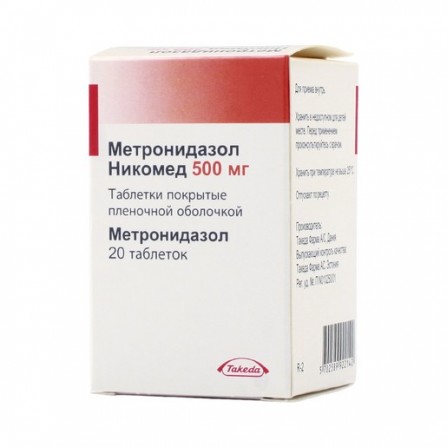Metronidazole Nycomed film coated pills 500mg N20
Condition: New product
Rating:
Be the first to write a review!

More info
Active ingredients
Metronidazole
Release form
Pills
Composition
1 tablet contains: Active ingredient: metronidazole 500 mg.
Pharmacological effect
Antibacterial, antiprotozoal
Pharmacokinetics
Almost completely absorbed after ingestion. Simultaneous food intake does not affect absorption. After administration of 200 mg, the maximum plasma concentration (about 5 μg / ml) is noted in approximately 1–2 hours. Less than 10% of the drug binds to proteins. Quickly distributed in the body.
Indications
Infections caused by anaerobic pathogens: wound infection, infection of the respiratory organs, urinary tract, intestines; prevention of anaerobic infection before intestinal surgery; trichomoniasis, amebiasis, giardiasis, Crohn's disease.
Contraindications
Diseases of the hematopoietic system, acute organic lesions of the central nervous system.
Use during pregnancy and lactation
Contraindicated.
Dosage and administration
Parenteral; adults and children over 12 years old: 500 mg (100 ml of infusion solution) 3 times a day, you can start the introduction with 1 g (200 ml). Children up to 12 years: 20 mg / kg of body weight per day (in 3 doses). Parenterally administered for 20-30 minutes in the form of drip infusion with an isotonic solution of sodium chloride or glucose solution. Parenteral administration is used only in cases of acute and severe infections, or in cases where oral administration is not possible. Orally: with trichomoniasis, 250 mg 2 times a day for 7–10 days or 2 g once. Sexual partners should be treated at the same time. For non-specific bacterial vaginitis, 500 mg 2 times a day for 7 days or 2 g on the first day and 2 g on the third day of treatment. In acute amebic dysentery and amoebic liver abscess, adults take 2 g daily for 2–3 days, children 35–50 mg / kg of body weight per day (in 3 doses) for 5 days. With asymptomatic intestinal amebiasis, adults take 750 mg 3 times a day for 10 days. With giardiasis, adults take 2 g per day once for 3 days, children 25–40 mg / kg per day (in 2 doses) for 7 days. For ulcerative gingivitis in adults, 250 mg 3 times a day for 3 days. With anaerobic bacterial infections in adults, 500 mg 3 times a day, children - 20 mg / kg of body weight per day (in 3 doses). Prophylactically during surgery, adults 1 g 2 hours before surgery, then 500 mg 3 times a day for 2–3 days, children 25 mg / kg 2 hours before surgery, then 20 mg / kg per day (in 3 doses ) within 2-3 days. With Crohn's disease in adults, 500 mg 2 times a day, children - 20 mg / kg per day (in 2 doses).
Side effects
Loss of appetite in the mouth, nausea, vomiting, diarrhea, headache, dark urine, leukopenia, polyneuropathy, urticaria, itching.
Interaction with other drugs
When used simultaneously with aluminum hydroxide-containing antacids with Kolestiramine, the absorption of metronidazole from the gastrointestinal tract is slightly reduced. When used simultaneously, metronidazole potentiates the effects of indirect anticoagulants. If you use it simultaneously with disulfiram, acute psychosis and impaired consciousness may develop. increased risk of toxic action when used simultaneously with metronidazole. When used simultaneously with lance prazolom possible glossitis, stomatitis and / or the appearance of dark colored language; with lithium carbonate - possible increase in the concentration of lithium in the blood plasma and the development of symptoms of intoxication; with prednisone - increases the excretion of metronidazole from the body due to the acceleration of its metabolism in the liver under the influence of prednisone. Perhaps a decrease in the effectiveness of metronidazole. When used simultaneously with rifampicin, the clearance of metronidazole is increased from the body; with phenytoin - a slight increase in the concentration of phenytoin in the blood plasma is possible, a case of the development of a toxic effect is described. With simultaneous use with phenobarbital, the excretion of metronidazole from the body increases, apparently due to acceleration of its metabolism in the liver under the influence of phenobarbital. It is possible to decrease the effectiveness of metronidazole. When used simultaneously with fluorouracil, the toxic effect increases, but not the effectiveness of fluorouracil. A case of acute dystonia after taking a single dose of chloroquine in a patient receiving metronidazole is described. When used simultaneously with cimetidine, inhibition of metronidazole metabolism in the liver may occur, which can to slowing its excretion and increase plasma concentrations. When ethanol is used simultaneously in patients receiving metronid ol, development disulfiramopodobnyh reactions.
special instructions
Metronidazole is used with caution in liver diseases. In combination with amoxicillin, they are not recommended for use in patients younger than 18 years.In the course of treatment, systematic monitoring of the picture of peripheral blood is necessary. During treatment, trichomonas vaginitis in women and trichomonas urethritis in men are recommended to abstain from sex; simultaneous treatment of both partners is mandatory. During the use of metronidazole, darker staining of the urine is observed. During the treatment period with metronidazole, alcohol should be avoided, since acetaldehyde accumulation may occur due to impaired alcohol oxidation. As a result, reactions similar to those characteristic of disulfiram (spastic abdominal pain, nausea, vomiting, headache, sudden flushing of the face) may develop.




